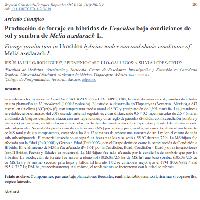Resumen
- Se evaluaron los híbridos de Urochloa CIAT BR02/1752 y CIAT BR02/1794, bajo condiciones de sol y sombra de árboles en una plantación de M. azedarach (1,000 árboles/ha). El estudio se desarrolló en Tlapacoyan (Veracruz, México), a 847 msnm, en un clima (A)C(m)w ́(f), con temperatura media anual >18 °C, y precipitación de 1,991 mm/año. Las gramíneas se establecieron en marzo del 2019 usando material vegetativo, a una distancia de 0.5 × 0.5 m, en parcelas de 2.5 × 5 m, en un diseño de bloques completos al azar con tres repeticiones y un arreglo de parcelas divididas con la condición (sombra y pleno sol) en parcelas, los híbridos en subparcelas, las fechas de muestreo en sub-subparcelas y la edad de rebrote en sub-sub-subparcelas. Se midió la producción de materia seca (MS) por hijato y por macolla, así como también el rendimiento de MS total y de sus componentes, cortando a las 8 y 12 semanas de rebrote una muestra de un 1 m2 en el centro de cada sub-sub-subparcela. El material cosechado se separó en hojas y tallos y se secó a 55 °C durante 72 h. La MS/hijato fue afectada por la Edad (P<0.0001) y Grupo × Edad (P<0.0003); con el Grupo definido como la combinación de Condición × Híbrido. El rendimiento de MS/ha fue afectado (P<0.01) por la Condición, Edad, Condición × Edad y otras interacciones (con Híbridos, Fechas y Edades de muestreo). La MS/hijato fue más afectada por la condición de sombrío que por los híbridos. La producción de forraje fue mayor a pleno sol (1026.8±72.6 kg de MS/ha) que bajo sombra (505.3±72.5 kg de MS/ha), y lo mismo sucedió para hojas y tallos. El híbrido 1752 se comportó mejor que el 1794 (1026.9±72.7 and 695.3±72.7 kg DM/ ha, respectivamente). Así mismo, el rendimiento se incrementó con la edad de rebrote.
- Urochloa hybrids CIAT BR02/1752 and CIAT BR02/1794 were evaluated under full sun and shade in a Melia azedarach L. plantation (1,000 trees/ha). The study was carried in Tlapacoyan (Veracruz, Mexico), at 847 masl, in an (A)C(m)w ́(f) climate, with a mean annual temperature >18 °C, and 1,991 mm of rain/year. The grasses were established in March 2019, using vegetative material planted at 0.5 × 0.5 m, in 2.5 × 5 m plots. The experimental design was a split-split-split plot in three complete randomized blocks, with full sun or shade conditions as main plots, the hybrids as sub-plots, the harvest date as sub-sub plots and age of regrowth as sub-sub-sub plots. Dry matter (DM) yields per tiller, plant and hectare were measured at 8 and 12 weeks of regrowth, harvesting a 1 m2 sample located in the middle of each sub-sub-subplot. Fresh material harvested was separated into leaves and stems, and dried at 55 °C for 72 h. The DM/tiller was affected by Age P<0.0001) and Group × Age (P<0.0003); with Group defined by the combination of Condition × Hybrids. DM yield/ha was affected by Condition, Age, Condition × Age, and other interactions (with Hybrids, Date and Age of Harvest). DM yield/tiller was more affected by Condition than by Hybrids. Total DM/ha yield was higher under full sun (1026.8±72.6 kg DM/ha) than shade (505.3±72.5 kg DM/ha), and the same happened for leaf and stem yields. Hybrid 1752 outyielded 1794 (1026.9 ±72.7 and 695.3±72.7 kg DM/ha, respectively). DM yield/ha also increased with age of regrowth.
